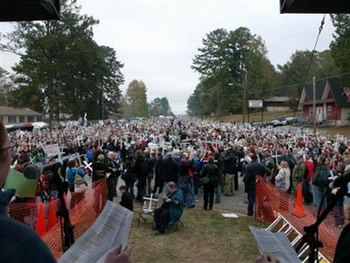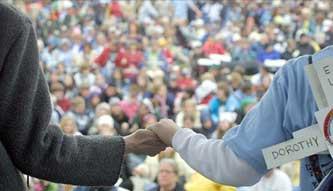Entered into the database on Monday, November 21st, 2005 @ 18:07:29 MST
'WE AIN'T GOING AWAY' The lyrics from the folk band were more than just catchy. To the tempo of protest and the beat of a strumming banjo, the chorus sent
a message. "Can't you see we're still here Can't you see we're still here Singing loud; Singing clear We shall not go under We're still here." There was no doubt Sunday they were still there, more than 15,000 SOA Watch
protesters gathered outside the main gate of Fort Benning. For the 16th consecutive
year, the protesters demanded the closing of the Western Hemisphere Institute
for Security Cooperation, formerly known as the School of the Americas. More than 40 people were believed to be arrested by military police and federal
marshals for crossing over onto Fort Benning. Columbus Police made at least
one arrest. "We ain't going away," said Father Roy Bourgeois, the
Catholic priest who founded the movement. "We have our hands on the plow;
and our eyes on the prize. We'll all go away when they shut that school down." Under cloudy skies and a misting early afternoon rain, Bourgeois was preaching
to the choir. Eric LeCompte, the SOA Watch Outreach and Events coordinator based in Washington,
D.C., echoed Bourgeois' sentiments, but he also spoke to the protesters' growing
list of concerns. "I hope they close it soon before we find out about any other foreign
policy concerns on base," LeCompte said. "They may never get rid of
us." Patricia Roberts of Lithonia, Ga., came to the protest to share her thoughts
of the war and of the institute. Her son, Jamall Addison, died in 2003, the
first Georgia soldier to be killed during the Iraq War. "I have been supporting the peace demonstrations nationwide," Roberts
said. "I feel that this is all linked together. It's all one entity because
violence promotes war." Orderly protest Columbus Police Chief Ricky Boren estimated the crowd at 15,000. SOA Watch
organizers estimated the crowd at 19,000. Boren said protesters were orderly. "There was very little problem," Boren said. "There were a couple
of arrests, but I don't think that was indicative of the crowd." As they have since the movement started in 1990 with six people, the protesters
are calling for the closing of the institute, which trains soldiers from Latin
and Central America. SOA Watch cites human rights abuses that have been committed
by military personnel trained by the U.S. Army. The protesters held a solemn funeral possession going down Fort Benning Road
to the main gate. Thousands of people followed mock coffins carried by people
in black robes, their faces painted white. Shortly after noon, protesters began looking for places to get through the
fence. It wasn't easy. There were two chain-link fences along most of the Fort
Benning property line at the gate, and an additional fence on Fort Benning Road
at the gate. Some protesters began lifting the bottom of the fence, allowing those who wanted
to go onto the post easier access than climbing over the fence, which was topped
with barbed wire. A Fort Benning spokesman said the post would not release names of those arrested
for trespassing Sunday. Spokesman Brad Castlebury also declined to release the
number of people arrested. Information on those arrested will be available this
morning, he said. SOA Watch officials estimated that more than 40 people went under or over the
Fort Benning fence and were being detained. Boren said he had been told about
40 were arrested. More than 100 protesters stood outside the Muscogee County Jail around 8 p.m.
Sunday to support the demonstrators who were arrested. They sang, chanted and
beat on drums in hopes that those inside the jail being processed could hear
them. Many didn't cross Sister Kathy Nelessen, a 63-year-old nun from Fon du Lac, Wis., was at the
fence watching fellow protesters cross the line. As she has done in her three
previous protest trips to Columbus, she chose not to go onto post. "I wish about 4,000 people would go," Nelessen said. "What would
they be able to do? Then I would go." Nelessen and others did notice something a little different about this year's
protest. The crowd is getting younger. College students have long been a mainstay
of the protest since its early days. Now more high school students are participating. Aaron Engelman, 16, of Binghamton, N.Y., climbed up the fence before the brown
tarp covering the fence was cut away by protesters. The junior from Bainbridge
Guilford High School wanted to see the government officials behind the gate. "I did it so they can see me," said Engelman. "The U.S. is responsible
for so many things that are going on. They have such a great dream, but there's
a lot of hypocrisy." For some, the protest is personal. Sonia Umanzor came to the protest for the first time. Umanzor said she left El Salvador in 1981 to escape persecution by paramilitary
groups. "This is incredible for me because I am so afraid to be close to the gates,"
Umanzor said. When she left her house the soldiers arrived and killed a close friend. "They shot him," Umanzor said. "I was accused of helping the opposition," said Unmanzor, who worked
as nurse. She visited villages and treated people who had been attacked. Umanzor
said she remembers helping a baby whose head had been cut by a machete. "We called her Angelita," which means angel, Umanzor said. It was
a miracle the baby survived, she said, "but she never left." When asked why she decided to attend the protest this year, Umanzor said, "I
decided I have to come. I feel tired to be with this feeling, with this anger,
pain. I feel like all of us need to be together and put together our strength
and faith to stop this now." Soldiers in the crowd Not everyone in the crowd was protesting. Army Pvt. Dustin Workman II and his friends said they were curious about the
gathering because they had to pay extra cab fare due to the closing of the main
gate. "I know it cost a lot to close the gate," said the soldier, dressed
in civilian clothes. "I just wanted to see what this was about." Workman, who recently graduated from basic training, is preparing to go to
Airborne School. While he and his friends, all sporting military crew cuts,
walked through the crowd, some of the protesters raised their brows and gave
them "dirty looks," Workman said. "I noticed people wearing military uniforms when they didn't even earn
it," he said. Chad Hatman, a former Army officer from Philadelphia, was wearing his Army
uniform top, complete with captain's bars and an Airborne patch. He is now a
member of Iraq Veterans Against the War. "People who join the military want to do something honorable," Hartman
said. "That honor is betrayed and exploited by the corruption of our own
government. Being here is something that is more honorable than being a pawn
for a corrupt agenda." Staff writer Kelli Esters contributed to this report.

